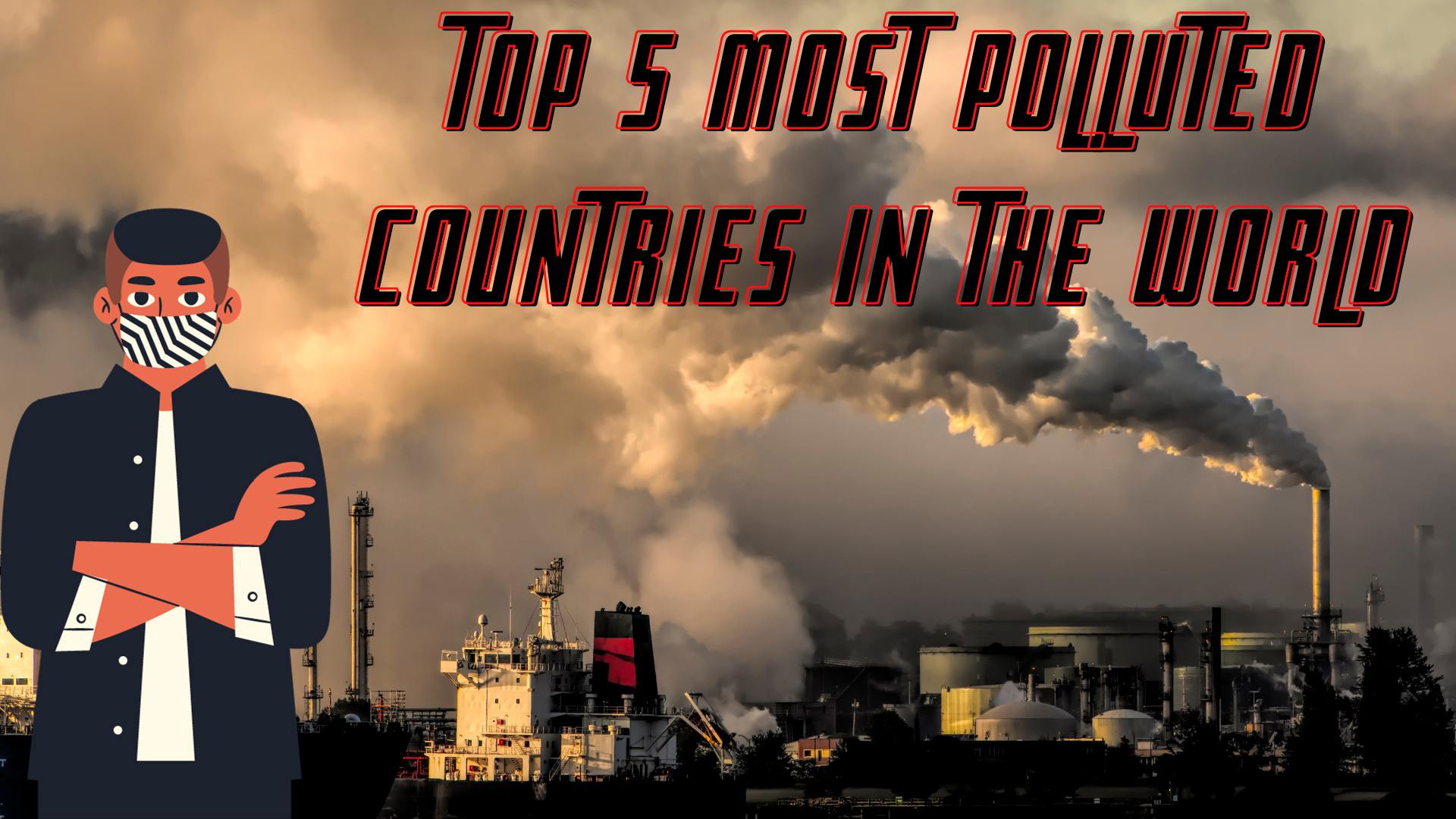Most Polluted Countries : Welcome to our blog post on the top 5 most polluted countries in the world! In this eye-opening article, we will delve into the alarming issue of air pollution and its impact on our planet. We’ll also explore the concept of PM2.5 pollution, understand how it affects us, and reveal which countries are grappling with dangerously high levels of contamination. So fasten your seatbelts as we embark on a journey through these polluted hotspots and discover what measures are being taken to combat this global crisis. Let’s dive right in!
Air Pollution and Its Impact

Air pollution, a pressing issue that affects millions of people worldwide, poses significant threats to human health and the environment. The release of harmful pollutants into the air can have detrimental effects on respiratory systems, leading to an increase in asthma cases and other respiratory diseases. But it doesn’t stop there – air pollution also impacts our cardiovascular health, with studies linking it to heart attacks and strokes.
Not only does air pollution harm human beings, but it also takes a toll on our planet. It contributes to climate change by releasing greenhouse gases like carbon dioxide into the atmosphere. These gases trap heat from the sun, causing global temperatures to rise and disrupting weather patterns.
Moreover, polluted air can harm ecosystems and wildlife. Acid rain resulting from air pollution damages forests and bodies of water while harming aquatic life as well. The deposition of pollutants onto plants can stunt their growth or even kill them off entirely.
The impact of air pollution is far-reaching – from endangering human lives to damaging delicate ecological systems. As we become more aware of these consequences, efforts are being made globally to tackle this issue head-on through stricter emissions regulations, renewable energy initiatives, and innovative technologies aimed at reducing pollutant emissions.
Understanding PM2.5 Pollution
Air pollution is a significant global problem that affects the health and well-being of millions of people. One particular pollutant of concern is PM2.5, also known as fine particulate matter.
PM2.5 refers to tiny particles measuring less than 2.5 micrometers in diameter, which can easily penetrate deep into our respiratory system when inhaled. These particles come from various sources such as vehicle emissions, industrial processes, and burning of fossil fuels.
The impact of PM2.5 pollution on human health cannot be overstated. It has been linked to respiratory problems like asthma and bronchitis, cardiovascular diseases, reduced lung function, and even premature death.
Unfortunately, PM2.5 pollution is not limited to outdoor environments only; it can also infiltrate indoor spaces through inadequate ventilation or the use of certain household products.
To mitigate the effects of PM2.5 pollution, governments around the world need to implement stringent air quality standards and promote cleaner energy sources for industries and transportation systems.
Moreover, individuals can play their part by reducing their personal exposure to these harmful particles through measures such as using air purifiers at home or wearing masks when outdoor air quality is poor.
Read More: Top 10 Best Hotels In New York City
Methodology and Data Sources
To determine the top 5 most polluted countries in the world, extensive research and data analysis were conducted. A variety of reliable sources were consulted to gather accurate information on air quality levels and pollution indices across different nations.
One key source utilized was the World Air Quality Index (AQI), which provides real-time data on air pollution levels in various cities around the globe. This data helped establish a baseline for understanding overall air quality trends in each country.
Additionally, reports from reputable organizations like the World Health Organization (WHO) and environmental agencies of individual countries were examined. These reports offer detailed insights into factors contributing to air pollution such as industrial emissions, vehicular exhaust, biomass burning, and more.
It’s important to note that the methodology employed considered PM2.5 pollution specifically – fine particulate matter responsible for numerous health issues when inhaled. PM2.5 refers to particles smaller than 2.5 micrometers in diameter that can penetrate deep into our lungs.
By analyzing data from multiple credible sources and focusing on PM2.5 concentrations, researchers were able to rank countries based on their level of air pollution accurately.
Now let’s delve into some specific findings regarding the most polluted countries globally!
Top 5 Most Polluted Countries in the World

Bangaldesh: The Most Polluted Country
When it comes to air pollution, Bangladesh takes the unfortunate crown as the most polluted country in the world. This South Asian nation is known for its dense population and rapid industrialization, which have contributed to high levels of pollution.
The primary culprit behind Bangladesh’s polluted air is PM2.5 particles. These tiny particles, measuring 2.5 micrometers or less in diameter, can easily enter our respiratory system and cause a range of health problems. With industries releasing pollutants into the atmosphere and widespread use of fossil fuels for cooking and heating, it’s no wonder that these harmful particles are abundant in Bangladeshi air.
The impact on public health has been severe. According to research by AirVisual, an IQAir company specializing in air quality data analysis, more than 150 million people in Bangladesh are exposed to unhealthy levels of PM2.5 pollution every year.
Furthermore, this toxic air poses significant risks for vulnerable groups such as children and the elderly who may already have underlying health issues. Respiratory diseases like asthma and bronchitis have become increasingly common among residents due to long-term exposure to polluted air.
Efforts are being made by both government authorities and non-governmental organizations (NGOs) to combat this alarming issue through measures such as stricter emission controls on vehicles and promoting renewable energy sources.
Improving air quality requires a holistic approach involving not only government intervention but also individual actions like reducing reliance on fossil fuels, using cleaner modes of transportation, and practicing sustainable living habits.
While Bangladesh faces many challenges in tackling its severe pollution problem head-on due to socio-economic factors, there is hope that with continued efforts from all stakeholders involved – including citizens themselves – steps can be taken towards breathing cleaner air for future generations.
Pakistan: Second-Highest Air Pollution
When it comes to air pollution, Pakistan has unfortunately earned itself a notorious reputation. The country ranks as the second-most polluted in the world, with major cities like Lahore and Karachi grappling with smog-filled skies year-round.
One of the primary contributors to this alarming level of pollution is vehicular emissions. With an increasing number of cars on the roads and lax emission control standards, Pakistan’s urban areas have become hotspots for toxic pollutants such as nitrogen dioxide and particulate matter.
Industrial activities also play a significant role in exacerbating air pollution levels. Many factories operate without proper environmental regulations or emission controls, releasing harmful substances into the atmosphere unchecked.
The burning of fossil fuels for electricity generation further adds to Pakistan’s air quality woes. Outdated power plants that rely heavily on coal contribute significantly to the high levels of sulfur dioxide and other pollutants in the air.
Geographical factors also contribute to Pakistan’s poor air quality. The country experiences frequent dust storms from neighboring regions such as Iran and Afghanistan, which introduce additional particles into the already polluted atmosphere.
To combat this dire situation, Pakistani authorities have taken some steps towards improving air quality. These include implementing stricter vehicle emissions standards, promoting renewable energy sources like solar power, and launching awareness campaigns about the dangers of air pollution.
However, much more needs to be done to address this pervasive issue effectively. It requires a collaborative effort between government bodies, industries, communities, and individuals alike to adopt sustainable practices that can mitigate air pollution’s hazardous effects on public health and improve overall environmental well-being.
India: Third-Highest Air Pollution
India, the land of vibrant colors and rich cultural heritage, is unfortunately grappling with a major environmental issue – air pollution. With its rapid industrialization and growing population, India has found itself ranked as the third most polluted country in the world.
The main culprit behind this alarming situation is PM2.5 pollution – tiny particles suspended in the air that are harmful to human health. These particles can penetrate deep into our respiratory system and cause various respiratory illnesses such as asthma and bronchitis.
Several factors contribute to India’s high levels of air pollution. One significant factor is vehicular emissions from an ever-increasing number of cars on the roads. Additionally, industrial activities, inefficient waste management practices, agricultural burning, and coal-fired power plants all contribute to worsening air quality.
Despite government initiatives such as introducing stricter emission norms for vehicles and promoting renewable energy sources, tackling air pollution remains a daunting task for India. The challenge lies not only in implementing effective policies but also in raising awareness among citizens about their role in reducing pollution.
Efforts are being made to combat this grave issue through measures like introducing electric vehicles, promoting public transportation systems, encouraging tree plantation drives, and adopting cleaner technologies in industries. However, sustained efforts at both individual and collective levels are necessary to see a significant improvement in India’s air quality.
It’s crucial for every citizen to understand their responsibility towards protecting the environment by adopting sustainable practices like using public transport or carpooling whenever possible; avoiding burning waste; supporting clean energy sources; planting trees; and regularly maintaining vehicle exhaust systems.
While it may take time before we see substantial changes on a national scale, every small step counts towards making a difference for future generations who deserve clean air to breathe.
Mongolia: Fourth-Highest Air Pollution
Mongolia, a landlocked country in East Asia, might not be the first place that comes to mind when you think of air pollution. However, it has earned its spot as the fourth-highest-polluted country in the world. The main contributor to Mongolia’s severe air pollution is its heavy reliance on coal for heating and cooking during harsh winters.
The use of traditional stoves called “ger” is widespread in rural areas, where approximately 60% of Mongolians live. These stoves burn low-quality coal, releasing high levels of particulate matter into the atmosphere. In addition to household emissions, industrial activities such as mining also contribute significantly to air pollution.
During winter months known as “dzud,” when temperatures drop well below freezing and snow covers vast areas, the situation worsens. People burn even more coal for warmth and survival.
Furthermore, Mongolia’s unique geography exacerbates the problem. Its capital city Ulaanbaatar sits in a valley surrounded by mountains that trap pollutants within the city limits.
To combat this issue, efforts are being made to transition from traditional stoves to cleaner alternatives like electric heaters or improved stove technologies. Additionally, increasing public awareness about the health risks associated with air pollution is crucial for long-term change.
Mongolia still faces significant challenges in tackling air pollution effectively due to economic constraints and cultural practices deeply rooted in tradition. However steps towards reducing reliance on coal and promoting cleaner energy sources will undoubtedly play a vital role in improving air quality for future generations.
Afghanistan: Fifth-Highest Air Pollution
Afghanistan, a country known for its rugged terrain and rich cultural heritage, unfortunately also finds itself among the top 5 most polluted countries in the world. The fifth-highest air pollution levels in Afghanistan are a cause for concern and have significant implications for the health and well-being of its population.
One of the major contributors to air pollution in Afghanistan is industrial emissions. With limited regulations and outdated infrastructure, industries often release harmful pollutants into the atmosphere without proper filtration or containment measures. This leads to increased levels of particulate matter (PM2.5) and other toxic substances in the air.
Another factor contributing to high air pollution levels is household burning of solid fuels such as coal and wood for cooking and heating purposes. In many rural areas, these traditional methods are still widely practiced due to limited access to clean energy sources. The resulting smoke from these practices further deteriorates air quality.
Additionally, Afghanistan’s geographical location exacerbates its pollution problem. Surrounded by mountain ranges that trap pollutants within valleys, it becomes difficult for stagnant air masses to disperse effectively. This phenomenon, known as temperature inversion, can lead to prolonged exposure to polluted air.
The consequences of this alarming level of air pollution cannot be underestimated. It poses serious risks to public health with increased cases of respiratory diseases such as asthma and bronchitis among both children and adults. Moreover, long-term exposure can contribute to cardiovascular diseases, lung cancer, premature death, and overall reduced life expectancy.
Efforts are being made towards combating this issue through collaborations with international organizations like UNICEF and WHO that aim at improving indoor household environments by promoting cleaner cooking technologies such as LPG stoves or solar-powered alternatives. Additionally, initiatives focusing on reducing vehicle emissions through stricter regulations have been implemented.
Disclaimer
All the information given in this blog is for your information only and is not used for commercial purposes. Although we do not ensure the accuracy and completeness of this information. We make every possible effort to do so, but there may still be some errors in it. We Will not be held liable in any way for possible damages arising from the use of the article.




